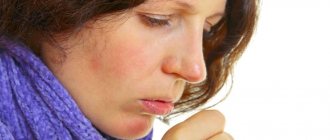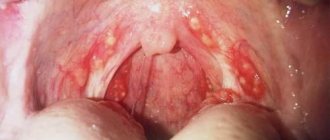Is it possible to swallow phlegm in the throat?
The accumulation of mucus in the throat forces the patient to pay attention to it.
There are only two options: expectoration or swallowing. Both processes are physiological. Swallowing is harmless: sputum passes into the stomach and is broken down into components. Enzymes in the gastric juice transform mucus into water, which returns to the body and brings only benefits. Harmful components are digested and excreted naturally.
The feeling of mucus in the throat due to hypersecretion of the glands of the respiratory system is normal. These nerve endings signal stagnation of phlegm. The main thing is the absence of suffocation, which is a dangerous sign of the development of events: swelling of the larynx with a threat to life.
Sputum in the lungs by composition
Diagnostics
The initial examination of a patient with complaints of mucous sputum is often performed by a general practitioner, who, if necessary, gives a referral to an otolaryngologist or pulmonologist. To make a preliminary diagnosis, it is enough to collect complaints, auscultate the lungs, and visually examine the tonsils and pharynx. The plan for clarifying diagnostic studies includes the following methods:
- ENT examination.
With direct and indirect laryngoscopy, the doctor assesses the condition of the laryngeal mucosa, identifies signs of inflammation and hypertrophy. Using a fibrolaryngoscope, a biopsy of atypical areas is performed. If a chronic runny nose is suspected, anterior and posterior rhinoscopy provides valuable information. - X-ray of the OGK.
Carrying out an x-ray in two projections allows us to identify changes typical of inflammatory or tumor processes of the bronchopulmonary system. To clarify the diagnosis, targeted studies are prescribed: fluoroscopy and MRI of the chest organs. - Endoscopic diagnostics.
During bronchoscopy, the mucous membrane of large and medium-caliber bronchi is visualized. The method is used to diagnose chronic bronchitis, neoplasia, fibrotic changes. Using endoscopy, biopsies for histological examination and bronchial lavage water are taken. - Sputum analysis.
Culture of bronchial mucus is necessary to identify viral or atypical bacterial infections. When microscopy of mucous sputum, attention is paid to pathognomonic crystals and spiral-shaped accumulations of mucus. To exclude tuberculosis, microscopy of the material after special staining is required.
Among laboratory methods, a general blood test is informative, allowing one to differentiate inflammatory and other pathologies of the respiratory system. In a biochemical study, acute-phase indicators are studied. Serological tests aimed at searching for antibodies to pathogenic microorganisms are recommended. To measure the function of external respiration and diagnose chronic diseases, spirometry and peak flowmetry are indicated.
Sputum analysis
Coughing up white mucus without coughing
Enveloping the larynx with white mucus without a reflexive attempt to remove it is a common reason for patients to see a doctor. Most often, this is pure physiology, not dangerous to health: unfavorable ecology, food irritating the mucous membranes, alcoholic drinks.
If, in addition to sputum, cold symptoms appear: runny nose, headache and fever, this is a reason to consult a doctor.
Most likely, acute respiratory infections provoked an exacerbation of a latent process, which is localized in the upper respiratory tract and does not manifest itself in anything other than hypersecretion of mucus. The pathology does not descend into the bronchi, so there is no cough. But such “innocence” may hide tumors of the nasopharynx, so consultation with a specialist is necessary.
For prevention purposes, any expectoration of white mucus without coughing for a couple of days is a reason to visit a therapist.
An examination with special equipment and a series of tests will allow you to determine the true cause of hypersecretion and prescribe therapy or send you to a specialized specialist.
Treatment
Help before diagnosis
To improve the discharge of viscous sputum, the postural drainage method is used: patting and tapping on the chest, being in a position with the head end down. Patients in satisfactory condition are recommended dosed physical activity. Special breathing exercises work effectively. Thick sputum production is a symptom of serious illness, so you should consult a doctor.
Conservative therapy
The main drugs for eliminating viscous sputum are mucolytics. Medicines consist of proteolytic enzymes and other active substances that thin bronchial mucus, improve expectoration, and eliminate congestion. To increase the effectiveness of mucolytics, they are combined with secretomotor drugs, which increase the volume of mucous secretions and accelerate their elimination. For etiopathogenetic purposes, therapy is also used:
- Antibiotics
. Prescribed for prolonged pneumonia, aggravated chronic bronchitis and bronchiectasis. They are selected taking into account the antibiogram. As a rule, a combination of 3-4 drugs intended for long-term use is selected in the treatment regimen for tuberculosis. - Bronchodilators
. Medicines from the group of beta-2 agonists and M-anticholinergics expand the lumen of the airways and improve the removal of viscous sputum. They eliminate the phenomena of shortness of breath and obstruction, and are effective for providing emergency assistance during an attack of suffocation. - Anti-inflammatory drugs
. Mild forms of pulmonary diseases respond well to treatment with nonsteroidal anti-inflammatory drugs (NSAIDs). Inhaled corticosteroids are also used, which relieve swelling of the bronchi and reduce mucus production. For long-term therapy, those suffering from bronchial asthma are prescribed sodium cromoglycate. - Antiallergic drugs
. Tablet forms are used: antihistamines, leukotriene receptor inhibitors. For atopic bronchial asthma in the period of remission, allergen-specific immunotherapy is performed.
Physiotherapeutic techniques are effective for liquefying viscous sputum: inhalations with alkaline solutions and medications, vibration massage of the chest, electrophoresis. Patients are recommended to take exercise therapy and regular breathing exercises. For chronic respiratory diseases, courses of speleotherapy and sanatorium-resort treatment are indicated.
Other reasons
If sputum accumulates in the throat due to allergies, then you should take antihistamines (Suprastin, Cetirizine, Loratadine, Tavegil). Relief should occur within the first day of using them. If the symptom is caused by reflux and reflux of stomach contents, then treatment is prescribed by a gastroenterologist.
It will be individual for each patient (with the use of enzymes, anti-inflammatory drugs and dopamine receptor blockers).
You will also be interested in:
- How to treat a dry cough in an adult that lasts for a long time without fever
How to gargle?
For the procedures, decoctions of medicinal plants are used, which have a vasoconstrictor and antiseptic effect. Gargling has a beneficial effect on the mucous membranes of the throat, eliminates cough, and removes unpleasant odor from the mouth. Treatment promotes intensive expectoration of mucus from the throat. It is advisable to rinse up to five times a day. It is recommended to use the following products as medicinal solutions.
- Infusion of medicinal herbs. Take 2 tablespoons of a suitable medicinal plant: mint, sage, calendula, chamomile, eucalyptus or celandine. The plant material is poured with a liter of boiling water and infused.
- Decoction of onion peels. Take 3 teaspoons of husk. Boil in a liter of water for 30 minutes.
- Apple vinegar. A teaspoon of vinegar is diluted in a glass of warm water.
- Clay solution. A teaspoon of green clay dissolves in a glass of warm water.
- Iodine-soda solution. Add 3 drops of iodine and half a teaspoon of baking soda to a glass of saline solution.
- Cranberry juice. Add a tablespoon of honey to a glass of cranberry juice.
Causes caused by pathological processes
Green sputum without cough is always the cause of an infectious disease. It can form or accumulate in the throat with the following pathologies:
- pharyngitis (inflammation of the larynx);
- rhinitis (inflammation of the nasal mucosa);
- nasopharyngitis (inflammation of the nasopharynx);
- bronchial or pulmonary diseases (usually chronic);
- tonsillitis (inflammation of the tonsils);
- allergy.
Most often, the feeling of phlegm in the throat occurs in people who suffer from laryngopharyngeal reflux or esophagitis.
Mucus drains from the nose down the back of the throat. Or it is thrown from the lower respiratory tract, esophagus. Irritation that occurs inside the pharynx increases the formation of sputum.
Viral and bacterial diseases that cause excess mucus in the throat are often accompanied by elevated body temperature. When fluid comes back from the esophagus, there is an unpleasant taste in the mouth.
Possible causes of sputum without cough and additional symptoms
Sputum is mucus that is secreted by glandular cells of the trachea, nasal cavity, paranasal sinuses and bronchi. Normally, no more than 100 ml of mucus accumulates in the tracheobronchial tree per day. It has bactericidal properties and is involved in the removal from the respiratory tract:
- dust;
- allergens;
- pathogenic agents.
When the mucous membrane is irritated, the activity of glandular cells increases 10 times or more.
Therefore, in case of illness, up to 4 liters of pathological sputum are produced per day. Expectoration of mucus without coughing is a nonspecific symptom that accompanies pathologies of various systems:
- respiratory;
- digestive;
- endocrine;
- nervous.
To find out the cause of the condition, you need to determine:
- the nature of sputum - elasticity, transparency, color, smell;
- associated symptoms – chest pain, sore throat, burning sensation in the nose;
- factors that provoke exacerbation are strong odors, physical activity, drinking hot drinks, etc.
Expectoration of mucus without coughing in half of the cases indicates damage to the nasopharynx or bronchopulmonary system.
Sinusitis and rhinitis
Thick mucus is released without coughing in case of inflammation of the nasopharynx and paranasal sinuses. Copious sputum is expectorated in the following diseases:
- The best cough syrup for children from all types
- Rhinitis (runny nose). Inflammation of the nasal mucosa is accompanied by the secretion of viscous mucus. Its transparency and elasticity depend on the form of the disease. An infectious runny nose produces yellow or green mucus. In people with insufficient tone of blood vessels, vasomotor rhinitis occurs, in which a transparent secretion is formed. With atrophic rhinitis, foul-smelling green sputum occurs.
- Sinusitis. When the maxillary sinuses become inflamed, sinusitis occurs, the ethmoid sinuses - ethmoiditis, the sphenoid sinuses - sphenoiditis, and the frontal sinuses - frontal sinusitis. If you cough up white, thick mucus without coughing, the cause of the illness is a viral infection or allergy. With bacterial and fungal inflammation, it acquires a yellow or green tint and an unpleasant odor.
Expectoration of mucus without coughing occurs mainly in the morning, as during the night it flows down the back wall of the throat into the hypopharynx.
Pharyngitis, laryngitis, tonsillitis
Phlegm in the throat without cough in children and adults occurs due to inflammation:
- palatine tonsils – tonsillitis;
- pharynx – pharyngitis;
- larynx - laryngitis.
If the secretion is transparent, this indicates the onset of the disease or the attenuation of inflammation. In the absence of complications, the cough does not bother you, and small amounts of sputum are expectorated. If it becomes thick and green, purulent inflammation is possible.
The release of viscous mucus without coughing after laryngitis is a sign that the inflammation has become chronic.
Reflux esophagitis
If there is no cough, but there is sputum in an adult, the cause may be the reflux of gastric contents into the esophagus - gastroesophageal reflux disease (GERD). Gastric juice contains hydrochloric acid, which irritates the mucous membrane and provokes the production of mucus.
GERD manifests itself:
- heartburn;
- sour taste in the mouth;
- swallowing disorder;
- hoarseness of voice;
- heaviness in the stomach after eating.
GERD is characterized by insufficiency of the esophageal sphincter.
The contents of the stomach enter the esophagus when the body is tilted or in a supine position. Therefore, clear mucus is coughed up after waking up. If you accidentally inhale gastric juice, a spasmodic cough occurs, accompanied by a burning sensation in the laryngopharynx.
Tuberculosis and other lung infections
Viscous mucus accumulates in the respiratory tract during infectious inflammation of the bronchi and lungs. Green sputum occurs when the ENT organs are damaged:
- Koch's bacillus;
- adenovirus;
- Staphylococcus aureus;
- pneumococcus;
- coronavirus;
- measles virus;
- peptostreptococcus;
- pyogenic streptococcus;
- corynebacterium.
Pathogenic microorganisms produce toxins, so signs of intoxication (poisoning) come to the fore:
- weakness;
- lack of appetite;
- headache;
- drowsiness;
- sweating
With viral inflammation, the sputum is clear, with bacterial inflammation it is yellow, and with purulent inflammation it is green.
If there is no cough and mucus accumulates in the bronchi, breathing becomes harsh. When listening with a stethoscope, moist rales are heard in the lungs.
Allergy
Sputum production without coughing is one of the signs of a respiratory allergy. Irritants (allergens) are:
- medicines;
- plant pollen;
- Food;
- fumes from household chemicals;
- dust mites.
Manifestations of respiratory allergies:
- Night cough in children and adults - causes of dry and wet cough, diagnosis and treatment methods
- labored breathing;
- redness of the throat mucosa;
- nasal congestion;
- lacrimation (with hay fever);
- pain when swallowing;
- hoarseness of voice.
Depending on the location of the inflammation, the allergy occurs with or without a cough.
Patients complain of expectoration of clear, viscous sputum, which sometimes becomes glassy. In the absence of treatment, the clinical picture is supplemented by new symptoms - spasmodic cough, shortness of breath, swelling of the mucous membranes.
Bronchitis
With inflammation of the bronchi, the production of bronchial secretions increases 5-7 times. At the initial stage, the cough appears and then disappears. When accumulated mucus irritates the receptors, coughing attacks occur. Without taking mucolytics, she does not expectorate, so wheezing appears in the lungs.
Symptoms of bronchitis:
- malaise;
- hard breathing;
- chest discomfort;
- nasal congestion;
- moderate increase in temperature.
After 2-3 days, the mucus begins to come out abundantly, so a productive cough occurs. It intensifies at night or in the morning, with a sharp change in temperature.
Sjögren's syndrome
Sputum without fever and cough is one of the signs of Sjögren's disease. It is characterized by damage to connective tissue and exocrine glands. Accompanied by sinusitis and tracheobronchitis, separation of rusty sputum.
Symptoms of Sjögren's disease:
- muscle and joint pain;
- dry eyes;
- seizures in the corners of the mouth;
- violation of the act of swallowing;
- prostration;
- dry tongue;
- formation of crusts in the nose;
- enlargement of the parotid glands.
The mucous membrane of the throat dries out and acquires a bright red tint.
If the glands are insufficient, the saliva becomes viscous. Due to dysphagia (impaired swallowing), the patient cannot swallow it. Therefore, there is a feeling of mucus accumulation in the throat.
Inflammation of the adenoids
Sputum without cough in a child appears against the background of adenoiditis. This is the name for inflammation of an enlarged nasopharyngeal tonsil. The adenoids block the nasal passages, so viscous secretions accumulate in the nasal cavity. During sleep, it flows into the throat through the back wall of the pharynx.
Manifestations of adenoiditis:
- night snoring;
- violation of nasal breathing;
- coughing up yellow mucus;
- restless sleep;
- headache;
- elevated temperature.
There is no cough while awake. It occurs in the morning or immediately after waking up due to irritation of the throat by nasal secretions. If left untreated, the Eustachian tube becomes inflamed (eustachitis), so the child complains of decreased hearing acuity and ear pain.
Esophageal diverticulum
An esophageal diverticulum is a saccular bulge in the wall of the esophagus. It manifests itself as dysphagia, bad breath, and a feeling of a lump in the throat. Many people experience hypersalivation - excessive production of saliva, so they complain of copious sputum discharge without coughing attacks.
Associated symptoms depend on the location of the diverticulum. The most striking clinical picture when a protrusion forms in the clavicle area:
- change in voice timbre;
- nausea;
- scratching in the throat;
- expectoration of thin sputum;
- regurgitation of food;
- backflow of mucus from the esophagus into the throat.
Large diverticula put pressure on the respiratory system, causing coughing. It is combined with chest pain and dizziness.
Consequences of smoking
Non-infectious bronchitis is a problem faced by smokers with more than 7 years of experience. Systematic damage to the bronchi by tobacco smoke leads to irritation and inflammation of the mucous membrane, which increases the activity of glandular cells.
Symptoms of smoker's bronchitis:
- rawness in the throat;
- occasional cough;
- mucus department;
- dyspnea;
- hard breathing;
- tachycardia (against the background of coughing attacks).
During the day, sputum passes without coughing. But during sleep, it accumulates in the throat, so in the morning coughing attacks occur, during which clots of transparent mucus are released.
Worm infestation
If a child or adult does not cough up clear or white sputum, the cause may be helminthiasis. In the acute phase, parasite larvae circulate in the blood and enter the bronchi. They irritate the mucous membrane, causing a productive cough. A person complains about:
- chest pain;
- swelling of the mucous membranes;
- shortness of breath;
- nausea.
When the mucus is swallowed, the worms enter the intestines, where they develop into adults. In the later stages, helminthiasis manifests itself:
- abdominal pain;
- unstable stool;
- weakness;
- sleep disturbance;
- elevated temperature;
- convulsions.
With a chronic disease, immunity decreases, so rhinitis, tracheitis, and influenza often recur.
Other reasons
Foul-smelling mucus without coughing is a dangerous symptom that occurs against the background of purulent inflammation of the ENT organs. Without treatment, complications are possible - abscess and gangrene of the lung, sepsis (blood poisoning).
Possible causes of expectoration:
- lungs' cancer;
- pulmonary syphilis, disintegration of syphilitic gum;
- bronchopulmonary carcinoma;
- cystic fibrosis;
- pulmonary mycosis;
- actinomycosis;
- bullous disease;
- pleural empyema;
- COPD
Yellow sputum without cough is a sign of bacterial diseases of the nasopharynx. If clots of dried blood are found in it, this indicates mucopurulent inflammation. Brown sputum in the morning without cough occurs with bronchiectasis and cardiac pathologies.










